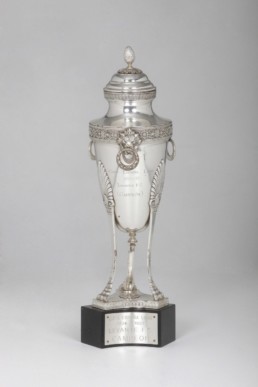Home / España Libre Cup / Where is it? / Universidad de Valencia
From 7 November 2016 until 19 February 2017, the Copa España libre could be seen at the Universitat de València as one of the objects in the exhibition entitled; ‘Tot està per fer. València, capital of the Republic (1936-1937)’, which was held in the Sala Acadèmia in the old Faculty in Calle de la Nave.
It took place on 7 November 1936. On that date, the government of the Second Republic left Madrid, faced with the siege of Franco’s troops, heading towards Valencia to turn the city of the Turia into the capital of the Republican government in the context of the Civil War that had broken out a few months earlier, in July 1936, following the uprising of General Francisco Franco. For almost a year, Valencia was the centre of attention and political, social and cultural activity during one of the most turbulent periods in Spain’s recent history. It was the eightieth anniversary of that period and of the taking of that decision, and the University of Valencia reconstructed everything that happened in that complex historical period in this exhibition.
The exhibition was produced by the Vice-rectorate for Culture of the University of Valencia, with the collaboration of Valencia City Council, Culturarts-IVAC, the ABC Graphic Archive and various libraries, archives and newspaper libraries, the Faculty of Geography and History of the University and the General Foundation of the University of Valencia, as well as other private institutions such as Levante UD. More than 450 objects were brought together, including photographs, audiovisuals with newsreels of the period and diverse documentation such as ration books, drawings of bombardments made by children of the time. In addition, there was a recreation of an enormous map of Valencia during the war, on which up to 85 renamed streets could be located, following the anti-fascist and revolutionary imaginary, as well as 80 places of special significance from a political, cultural and everyday point of view.
The Copa España Libre, which Levante won in July 1937, after beating Valencia in the final in Barcelona (1-0) with a goal by Nieto, formed part of the fixtures on offer. It should be noted that football activity did not decline during the first part of the war, even though national competitions were paralysed for obvious reasons. Despite the restrictions derived from the war, Levante maintained an intense activity in the interior of the green as part of the list of clubs that participated in the regional championship, which brought the curtain down on the 1936-1937 season, the Liga del Mediterráneo and the Copa España Libre, a competition which, at that time, usually closed the annual exercise. Levante made its team available to La República for friendly matches to raise funds for charitable causes. The story of this triumph is part of the centenary history of the Levante society, but also of the imagination of the Valencian people. Eighty years later, the trophy has once again acquired brilliance to be included in the context of which it formed part.
The challenge of this exhibition was to reconstruct what the city and its surroundings were like at that time, from very different perspectives, and how Valencians dealt with this life experience. Small stories are important; microhistory. “The uniqueness of this exhibition is that we are dealing with all aspects of life in Valencia during that period. Not only the cultural effervescence, which is perhaps the best known aspect, but also how anonymous people lived in the city, something that is not usually covered in history books,” said Toni Morant, lecturer in the Department of Contemporary History and one of the curators of this project, along with Mireia Ferrer and Javier Navarro.
